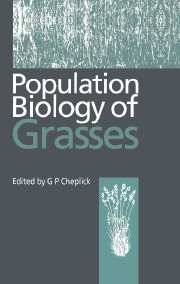Book contents
- Frontmatter
- Contents
- Contributors
- Preface
- Darwin revisited: approaches to the ecological study of grasses
- Part one Population variation and life history patterns
- Part two Ecological interactions
- Part three Population biology of specific groups
- 12 Population dynamics in the regeneration process of monocarpic dwarf bamboos, Sasa species
- 13 Population dynamics of perennial grasses in African savanna and grassland
- 14 A life cycle approach to the population ecology of two tropical grasses in Queensland, Australia
- Index
12 - Population dynamics in the regeneration process of monocarpic dwarf bamboos, Sasa species
Published online by Cambridge University Press: 14 September 2009
- Frontmatter
- Contents
- Contributors
- Preface
- Darwin revisited: approaches to the ecological study of grasses
- Part one Population variation and life history patterns
- Part two Ecological interactions
- Part three Population biology of specific groups
- 12 Population dynamics in the regeneration process of monocarpic dwarf bamboos, Sasa species
- 13 Population dynamics of perennial grasses in African savanna and grassland
- 14 A life cycle approach to the population ecology of two tropical grasses in Queensland, Australia
- Index
Summary
Introduction
The life history characteristics of bamboos differ conspicuously from other grasses in their peculiar flowering habits. Many bamboo species are long-lived monocarpic plants (McClure, 1966; Janzen, 1976; Soderstrom & Calderon, 1979; Simmonds, 1980; Veblen, 1982; Dransfield & Widjaja, 1995). In temperate regions in particular, the bamboos have long flowering intervals, estimated at 100 years or more (Janzen, 1976; Campbell, 1985). They often flower simultaneously over an extensive area and then die (Taylor & Qin 1988; Makita, 1992, Makita et al., 1993).
Bamboos often form exclusive dense populations with vigorous rhizomatous vegetative reproduction. After mass flowering and death, their populations recover mainly by the development of seedling cohorts (Veblen, 1982; Taylor & Qin, 1988; Makita, 1992; Makita et al., 1993). In clonal plants, the phase just after germination seems to be the most vulnerable period in their life history (Langer, Ryle & Jewiss, 1964; Kays & Harper, 1974; Cook, 1979; Solbrig, 1980; Bierzychudek, 1982; Liddle, Budd & Hutchings, 1982). Bamboos similarly suffer high mortality during seedling growth (Taylor & Qin, 1988; Makita, 1992, Makita et al., 1993). After die-off of bamboos, many other species may be able to invade the bamboo stands because light conditions at ground surface are improved considerably (Nakashizuka, 1988; Taylor & Qin, 1988; Makita, 1992). Especially in forests with an undergrowth of bamboos, the mass death of bamboos provides opportunities for tree regeneration (Veblen, 1982; Nakashizuka, 1987, 1988; Taylor & Qin, 1988, 1992, 1997; Taylor, Qin & Liu, 1995; Makita, 1997; Widmer, 1997). Thus the simultaneous flowering and death of bamboos is an important episodic event in the local vegetation dynamics.
- Type
- Chapter
- Information
- Population Biology of Grasses , pp. 313 - 332Publisher: Cambridge University PressPrint publication year: 1998
- 12
- Cited by



